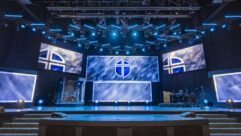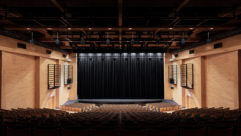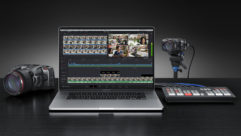Theater Adds Dramatic Sound
To compete for audience attention these days, live theaters have realized the importance of investing in AV technology to keep up with other entertainment venues.
CHALLENGE: Improve the poor sound and lighting quality in a small college theater, so it can also be used for live theater, local high school productions, and community events.
SOLUTION: Relamp the stage lights, and install a sound system with variable dispersion technology to ensure the best sound coverage in a small space.
Two Middle Atlantic SR-40-22 racks reside backstage at Clarendon College in Clarendon, TX, and hold most of the sound system’s power and effects. The racks were bolted together to move like one piece of equipment, and can be bolted shut for security.
With the rise of entertainment choices at home, it seems so much easier to stay in and watch a DVD on the big flat-panel TV than to get in the car and drive to see a live performance. To compete for audience attention these days, live theaters have realized the importance of investing in AV technology to keep up with other entertainment venues. At Clarendon College in Clarendon, TX, a small community college in the state’s panhandle, the addition of a theater faculty member marked the end of a six-year hiatus of theater programs, and also drove the need for upgrades to its Harned Sisters Fine Arts Theatre.
“The college has been around since 1898, but this 82-acre campus was built in the 1960s,” says Bill Huey, theater arts director for Clarendon College. “The sound system was put in during the 1970s and consisted of outdated loudspeaker gear. It was made for dance and band stuff rather than theatrical use.”
The existing system was a pair of cabinets set on the edge of the stage with the audio snake running up one side of the aisle and duct-taped to the stage. There were a few VHF wireless microphones and a single monitor mix for the stage.
Although Huey presents several live theater performances throughout the year to teach his students about live production, he doesn’t make any box office profits. With an annual budget of less than $1,000 (which includes office supplies), Huey relies on donations to round out the budget to run his department. “The challenge to educational theater is that there isn’t any money in it,” he says. “Available funds go to athletic teams or agricultural programs.”
To fund the needed audio and lighting upgrades, Huey applied for two grants — one for audio and one for lighting — totaling nearly $100,000. Once the grant money was approved, Huey sent out requests for proposals. “I did an analysis of the current technology, and found that we should scrap it and start over,” he says. “The lighting was so poor that I had problems lighting an 8-foot by 6-foot section of the stage!”
Mike Utzman, president of Euless, TX-based systems integrator Entertainment Systems Producers (ESP) of Texas saw Clarendon’s RFP on Onvia’s DemandStar service and decided to pursue it (for more information on this service, see the sidebar on page 28). “Clarendon had no specific brands listed, but listed performance requirements,” Utzman says. “We’re a small shop, so we can’t buy every brand at the best price in mass quantities; it’s not cost-effective. Therefore, we tend to go for bids like Clarendon’s. The original specs from Huey were 110 dB at the back of the room, which is loud for spoken word in a 500-seat house.”
Two TOA FB-120W subwoofers are installed alongside three TOA HX-SW loudspeakers above the theater’s curtain line.
The RFP required a site walkthrough before proposal acceptance, so Utzman and his crew drove the six hours to meet with Huey and Dr. Shelton, president of Clarendon College. Utzman spoke with Huey for four hours and walked away with a clear plan of action. The alternate bid was a goal of 98 dB at the back of the house. The specification was reduced at ESP’s suggestion because football games at the Cotton Bowl produce 98 dB, and levels closer to 110 dB were more suited for a rock concert.
“Originally, Huey didn’t give me a budget to work within,” Utzman says. “I found out after we won the bid that there was additional grant money. We had to add on $20,000 to the proposal since we had to use it all or lose it. We used the extra funds for a patch bay system and a DVD/CD recorder, among other things.”
Variable dispersion sound system
Similar to other old-style box theaters, the Harned Sisters Theatre suffered from an acoustical dead zone at the outer front row seats. The 85-foot-long by 60-foot-wide space is wide, but relatively short, with brick side walls and a cinder block back wall. Utzman needed speakers that could cover the dead zone, and were also powerful enough to reach the back row and small enough to hang above the curtain valances.
For the mono house system, three TOA HX-5W loudspeakers were hung in the left, center, and right positions with two TOA FB-120W subwoofers that are ceiling mounted just in front of the curtain line. Using the HX-5W’s variable dispersion design, Utzman was able to physically adjust each cabinet’s dispersion angle by 60, 45, 30, or 15 degrees. The adjustments allowed Utzman to more precisely aim the loudspeakers once they were installed in the space.
“I did one of TOA’s first conference systems installs, and have been installing and using them for 20 years,” Utzman says. “I remembered the HX-5s and thought they would fit the bill. I like that they’re single input cabinets, so all three are tied together. There’s no need for jumpers on the back.”
FINDING THE BUSINESS WITH DEMANDSTAR
The DemandStar service from Seattle-based government business intelligence provider Onvia is available via subscription to the company’s website. The service provides an aggregate listing of open bids across 55,500 federal, state, local and education purchasing offices. Subscribers can specify the type of bids they want to receive, and are notified when an opportunity matches the request. The service’s goal is to eliminate the need to scan individual trade magazines, websites, or newspapers for such opportunities. Subscribers can download bid documents and view blueprints on their own computer screens.
To use the service, bid opportunities are first matched to the subscriber’s business and sent to his or her account for review. Subscribers can click on a bid to see an overview, and then download the actual bid package for more information.
Subscription rates vary based on number of options to the service, coverage area, and number of offices that will use the information. Recent additions to the service include the San Diego Unified School District, the University of Texas at San Antonio, the city of Trenton, FL, and the city of Saint Paul, MN.
The lighting distribution was hung using swing set chain wrapped around 3/4 -inch conduit, so ESP took the opportunity to bring the system up to USITT standards. The ESP team installed unistrut and stainless steel cabling, which amounted to about two days of reworking. ESP also installed a new Soundcraft GB8 40-channel mixing console at front of house. Six Community MVP-12M loudspeakers serve as stage monitors, and 22 TOA F-1522SC 70 V speakers were installed to cover the dressing rooms, lobby, restrooms, offices, and other back room areas.
The amplifier and effects racks, as well as the wireless microphone system, were also reworked. ESP ran new conduit and cables through the ceiling into two Middle Atlantic SR-40-22 racks backstage. Two Phonic XP3100 amplifiers power the house loudspeakers; one Phonic XP500 powers the subwoofers; two Phonic Max 2500 power the monitor system; and a Phonic ICON 700 system powers the distributed 70 V system. The effects rack includes one JVC DRM-100S DVD/CD recorder, a Tascam CD-RW2000 CD player, a Denon DN-780R cassette player/recorder, a PreSonus ACP-88 comp/limiter, and a Yamaha Rev 100 reverb unit. Many of the products were chosen based on performance and budget considerations.
The project’s rack space presented yet another challenge. “Due to limited real estate, we customized the Middle Atlantic racks,” Utzman says. “The racks were designed to swing out in both directions, but there wasn’t enough room. We bolted the racks together and made a pass-through. That made it move like one door, but it can still bolt shut for security.”
A total of four four-channel Avlex MIPRO ACT-707F wireless microphone systems rounded out the new sound system. “The college sits on Highway 287, which is an overland trucking route,” Utzman says. “The old microphone system would pick up the CB truckers going by.”
To bring the theater up to ADA requirements, a Gentner 930-402-001 assisted listening system with 18 receivers was also added.
Overall, the house system produced 99 dB at the back of the room with only a -3 dB drop-off in the outside front corner seats, which was verified using an Ivie IE-35 audio analysis system. “The tight pattern control and variable angle allows us to cover the very front middle of the seating area without allowing spillover onto the stage,” Utzman says. “This eliminated a lot of feedback issues for performers using the 16 MIPRO wireless channels.”
FOR MORE INFORMATION
Avlexwww.avlex.com
Communitywww.loudspeakers.net
DemandStarwww.demandstar.com
Denonwww.usa.denon.com
Electronic Theatre Controlswww.etcconnect.com
Gentner Assistive Listening Systemswww.gentnerals.com
Ivie Technologieswww.ivie.com
JVCwww.jvc.com
Middle Atlanticwww.middleatlantic.com
Phonicwww.phonic.com
PreSonuswww.presonus.com
Soundcraftwww.soundcraft.com
Tascamwww.tascam.com
Yamahawww.yamaha.com
Clarendon College serves eight counties surrounding Clarendon, TX. As the only working theater in that area, it’s also used for regional University Interscholastic League high school theater competitions and for town hall meetings. Huey says that the new system was easy enough to use that he could train his students and the high schools to use it. “The stage has always been open for high school productions, but it’s more inviting now,” he says. “Hosting such events is also a good way for me to recruit potential students into the theater program. The sound system is well-balanced and puts out huge sound.”
As part of its proposal, ESP also revamped the stage lighting. Some work was done on the lighting five to six years ago, so the dimming and the electrical distribution remain unchanged. Instead, ESP installed a series of new Electronic Theatre Controls (ETC) fixtures. The Harned Sisters Theater is now standardized on ETC lighting, so there’s only one lamp to keep in stock for all of the different fixtures. “Considering the tight budget, this cost savings measure will add up over time,” Huey says.
The next steps for the theater are the addition of a movie screen and a projector, pending grant approval. Huey says the idea is to turn the theater into a community center by showing movies in addition to live performances. “The biggest problem with theater is that technology changes,” he says. “Most colleges still have a proscenium stage; any theater in the round is considered ‘experimental,’ even though it hasn’t been experimental in decades. If theater is to survive, you have to keep up with technology.”
Linda Seid Frembes is a freelance writer and PR specialist for the professional AV industry. She can be reached at [email protected].










